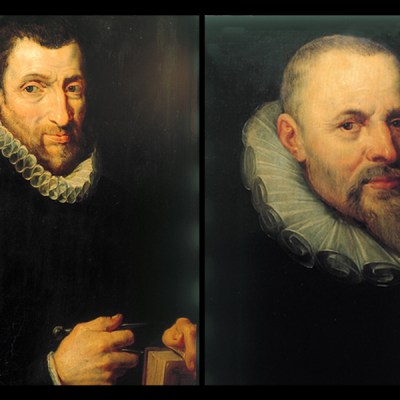From the October 2022 issue of Apollo. Preview and subscribe here.
Museum openings are often described as ‘much anticipated’ when it is often truer to say that they are welcome when they come along; usually a good thing – something to check out when you can, sometimes even make special plans to see – but they rarely give rise to years of waiting, even if you work at an art magazine. After being closed for 11 years, however, the Royal Museum of Fine Arts Antwerp (or Koninklijk Museum voor Schone Kunsten Antwerpen; KMSKA), which reopened on 24 September, really has been long awaited, not just long overdue.
When the Flemish government announced an international competition to come up with a new masterplan for the museum in 2003 and awarded the commission the following year, no one could have thought it would take so long to fulfil. However Carmen Willems, general director of the KMSKA since March 2020, says that she had been surprised when, in a purely private capacity, she attended the exhibition presenting the various plans. She remembers thinking, ‘This seems so complicated and so unrealistic, because it’s far easier to set up a new building next to the historical one, they are never going to choose this one.’ The winning proposal by the Dutch firm now called KAAN Architecten was to create a whole new set of galleries for the museum’s modern works, which had previously played second fiddle to its Old Masters, by inserting the new white-cube spaces into four existing courtyards and laying another gallery along the top – all invisible from outside the museum.
View of the modern works in the ‘Colour’ section of the new extension. Photo: Karin Borghouts
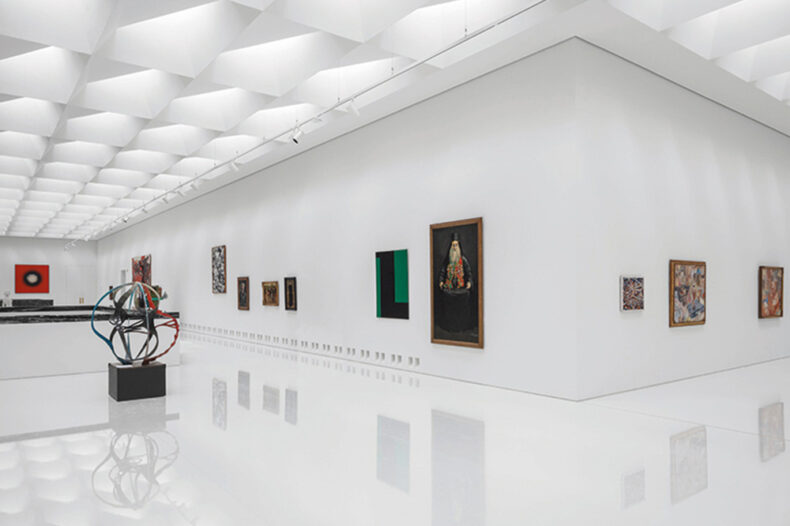
The KMSKA was meant to remain open, but after building consent was obtained and the work – which involved first removing all the 20th-century accretions – began, asbestos turned out to be a bigger problem than anyone had anticipated, the climate-control system needed replacing in its entirety and, crucially, local politicians regarded the project with significantly different levels of warmth and the money to allow the project to finish took years to be granted. An opening date of 2017 was pushed back to 2019; the museum’s long-time general director retired in 2014; his successor, the art historian Manfred Sellink, left (by mutual agreement with the board) in early 2020 to be replaced by Willems, an economist not an art historian by training who was the museum’s managing director. The KMSKA remained closed. In January 2022, an artistic director left (again, by mutual agreement) after being in post for only three months. The sector-wide closures of the pandemic may have removed some of the pressure, but there may have been some scepticism about the announcement of a firm reopening date of 24 September.
When I visit the museum in late August, however, the race to get it ready is nearly run. Outside, the garden is still being landscaped, with paths to be finished and rubble waiting to be taken away. Inside, lighting arrangements are being finalised in the galleries where paintings have already been hung; just a few rooms are still waiting for their residents, leaving at least one enfilade where my eye – undistracted by any works on the walls – is drawn straight to the other end.
Talk of enfilades belongs to the architectural language of the 19th-century museum, of which the building that has housed Antwerp’s most important collection of paintings since 1890 is a prime specimen. After Jean-Jacques Winders and Frans Van Dijk, the 20-something architects who won the commission in 1879, came back from a fact-finding tour of European museums (mainly in Germany), they singled out for praise the Alte Nationalgalerie and Altes Museum in Berlin. Fans of neoclassical temples with horse-drawn chariots on the roof will not be disappointed by their facade.
In 2022, it is still possible to enter the museum via the existing portico (there is also a new, accessible entrance on the side) and, for a moment, think that nothing has changed during the renovation (or perhaps even since 1890). This way leads us into the Keyserzaal, named after the painter whose series The Fame of the Antwerp School (1862–72) valorises the local tradition. Nicaise De Keyser’s cycle of history paintings is thoroughly out of fashion and hung at a height where it impresses but doesn’t demand to be looked at – but it still gets across the point that what we are entering is, at the end of the day, a local museum. It’s just that when your most famous local painter is Rubens, followed by Van Dyck, and other homegrown talents include the likes of Jacob Jordaens, Frans Floris and Quinten Massys, the local museum is likely to be of considerable outside interest. Of modern Flemish painters, thanks to a series of gifts and the occasional purchase, KMSKA has the largest collection of works by James Ensor and his younger contemporary, Rik Wouters.
Woman on a Breakwater (1880), James Ensor. Royal Museum of Fine Arts Antwerp.
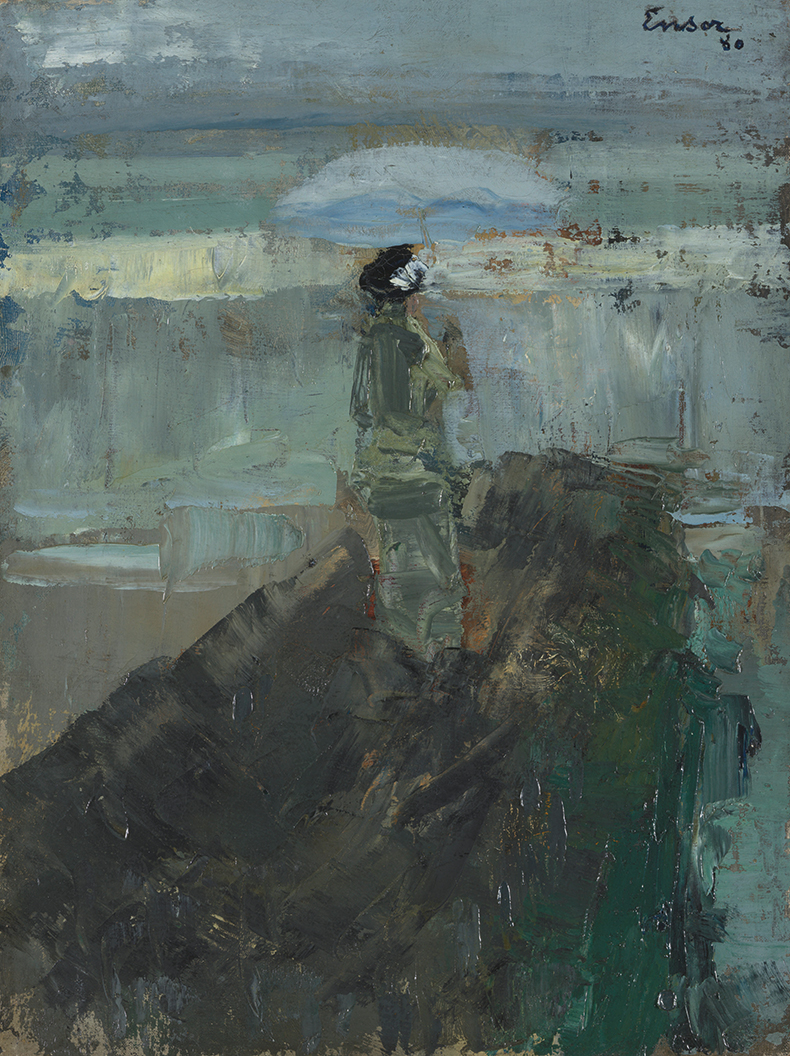
Carmen Willems is clear-eyed about the strengths and weaknesses of Antwerp’s most important museum. It is rather refreshing to hear the head of a major institution describe its collection as ‘quite challenging’. The total of 5,000 works (or 8,000 depending on how you count the contents of sketchbooks) is small by international standards, but ‘it doesn’t matter since the quality […] is very high’. Willems also calls the collection ‘eclectic’, but perhaps it is fairer to say that it has been formed by a combination of chance and careful planning that is common to all historic institutions (but manifests differently each time), requiring them to keep imposing new forms of order on their holdings.
The victory of the French Revolutionary army at Fleurus in 1794 led to the occupation of Antwerp, annexation of the Southern Netherlands and seizure of works of art from the churches, convents and guild halls of its cities. Later, in 1810, Napoleon added to the list of museums he is responsible for founding by decreeing the establishment of another in Antwerp on the site of a former monastery, to which the city’s art academy and its collection were also to move. Among the paintings carted off to the Louvre and returned only after Napoleon’s fall, in time for the new museum opening its doors in 1816, are vast altarpieces by Rubens that had been commissioned for churches in the city.
Some of the collection’s largest paintings by Rubens, including the Enthroned Madonna Adored by Saints (c. 1628) and The Adoration of the Magi (1624–25) can be found, as before, in the gallery that was built especially to house them. While the rest of the museum’s collection was removed during the renovation, these works were simply too large to be relocated. Some 200 paintings were restored during their long absence from the building, but the Enthroned Madonna Adored by Saints is waiting for its turn. Koen Bulckens, curator of Old Masters, says its restoration will easily take three to four years altogether. As if posing an arithmetic problem, he suggests that, since restorers typically take on multiple commissions, it would take two people working three days a week at least a year just to remove the discoloured varnish from the painting.
View of The Adoration of the Magi (1624–25) by Peter Paul Rubens in the Rubens Gallery. Photo: Karin Borghouts
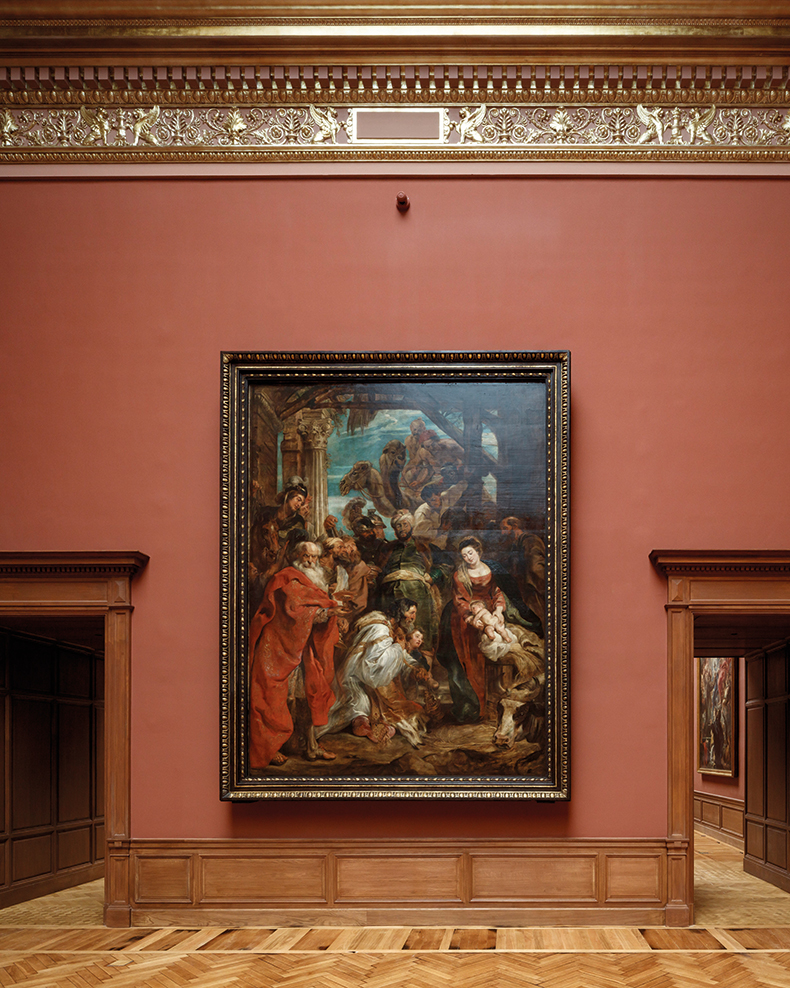
The centrepiece of the Rubens Gallery is The Adoration of the Magi, one of the few major altarpieces that experts agree is entirely autograph and which, Bulckens says, was (if you believe one old source) painted in only two weeks. Singling out the central figure of Balthazar, the most orientalised of the three eastern kings, Bulckens points out his robes are a green variant of the ‘Turkish’ costume brought back from Aleppo by a Flemish merchant who had had Rubens paint him in them a few years earlier. It is in part by pointing out this kind of detail on wall texts – and highlighting some of the extraordinarily eye-catching brushwork – that the museum plans to bring alive works that may seem more remote to modern audiences.
Under Willems, the new KMSKA has evidently worked hard on what she calls ‘storytelling’ – the presentation of the collection to a broad public, or a broader public than before. It is hard to think of an institution that doesn’t talk like this today, but Willems seems more committed to this way of thinking – and acting on it – than some directors. Her previous museum experience includes being director of the Gallo-Roman Museum in Tongeren in north-east Belgium. Willems describes it as having ‘a collection of no importance. When you have a modest collection, you really have to put effort into attracting people and you have to put effort into telling stories.’ Under her directorship, the Tongeren institution was European Museum of the Year in 2011. In Antwerp, however, the challenge for the city’s most prominent public museum is not to attract anyone at all, but rather to attract a cross-section of visitors representative of an increasingly diverse city, those who, as Willems puts it, might say: ‘“Fine art, what is this, is it something for me?”’
To this end, the museum’s curators and educational staff have been running a project called ‘The Finest Hundred’. The term applies both to 100 core works from all periods that will always be on display and to a volunteer, but carefully vetted, group of 100 Antwerp residents, who have acted by turn as consultants and guinea pigs for all of the museum’s innovations. ‘I’m pretty confident,’ Willems says as she describes the effect of this collaboration on who might visit, ‘that if we compare 100 visitors of the old museum to 100 visitors of the new museum, that we will see the difference.’ She also wants to get visitors’ attention by focusing on details from individual works. So far, so connoisseurial, then? But this is to be done not just through informative labels helping us appreciate Balthazar’s green outfit in The Adoration of the Magi, nor by the gently thematic arrangement that replaces the rigidly chronological hang of the previous layout, but also through at least one playful venture for children that isn’t embarrassed to be silly. The Belgian artist and opera director Christophe Coppens was commissioned to make ten sculptures, which lurk in the galleries of the paintings containing the details that inspired them. In the room next on from the Rubens Gallery, Maerten de Vos’s surreal The Temptation of Anthony (1594) gets an absurd playmate in the form of a giant skull set on the floor some distance away. It’s modelled on a skeletal velociraptor-like creature being ridden by a couple of extras straight out of Hieronymus Bosch (who had tackled the same subject) in the painting. The head is clearly meant for children and entirely ignorable, but if it sounds simply stupid, De Vos’s painting may be able to provide sensible advice to the sniffy. To the bottom right of the painting is a small fox dressed in pilgrim garb, diligently absorbed in his reading and ignoring the saint’s supernatural assailants – just as the painter (vos, by the way, means ‘fox’ in Dutch) might have us do.
Madonna Surrounded by Seraphim and Cherubim (c. 1450), Jean Fouquet. Royal Museum of Fine Arts Antwerp. Photo: Karin Borghouts

Thanks to the stripping out of ad hoc elements from the Old Masters part of the museum and the addition of new modern galleries, the museum’s wall space has increased by 40 per cent. Unlike most museums that have expanded and are eager to show more works overall, in Antwerp there has been a paring-down. Only 650 works are now on show, rather fewer than before. A case in point is the large, high-ceilinged room that contains three of the KMSKA’s most significant works. They are – hung one to a wall – the small Van Eyck panel, Madonna at the Fountain (1439), which faces Rubens’s The Holy Family with the Parrot (1614–33). The triptych of very different Virgins is completed by what may be the public face of the museum and is certainly one of the most fashionably dressed Madonnas in art history. Jean Fouquet’s Madonna Surrounded by Seraphim and Cherubim (c. 1450) is half of the Melun diptych, the other half of which depicts its commissioner Étienne Chevalier and Saint Stephen and is at the Gemäldegalerie in Berlin. The almost grisaille Madonna with three blue and six red angels came to the museum in 1841 as part of a bequest of some 144 Northern Renaissance from Florent van Ertborn, a former mayor of Antwerp with a passion for the Flemish Primitives that was not widely shared in his day. On what acts as a fourth wall, but are really two door posts, are two modern works: one by Luc Tuymans, the other by Marlene Dumas. They are part of a sparse sprinkling of the new among the old, mirrored by the insertion of a Bruegel or somesuch in the new galleries – but there’s no heavy-handed attempt to draw parallels, and the lighting scheme, which is being adjusted as we walk around, is making the most of the Madonnas. The aim, Bulckens says, is ‘to create a sacred space’ for the three stars.
A display of small terracotta modelli, including Joannes Cardon’s Madonna of 1643 (far right). Photo: Karin Borghouts
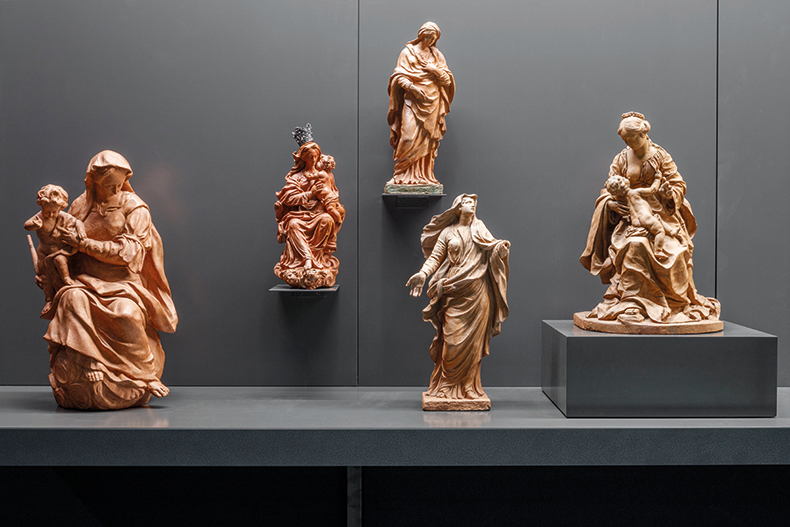
James Ensor is the artist who divides old from new by beginning the run of the gleaming white galleries. In the run-up to opening, the museum made much of it having created what amounts to a museum within a museum – and for visitors to go around each one without being much aware of the other. It wasn’t exaggerating. In the space separating the structure of 1890 from those of 2022, the architect has carved out a third set of spaces. Bulckens calls it ‘a twilight zone’: an ink-blue and slate- grey sequence of galleries designed for sketches, works on paper and small-scale sculptures. The latter includes an arresting display of modelli, fired-clay figures that were treated by sculptors almost as sketches (to be taken up in marble if approved), although examples such as Joannes Cardon’s breastfeeding Madonna of 1643 may be too finely detailed to be anything but the final product.
A few purists – the 100 old visitors of Willems’ imagination, perhaps – may dislike the mild shaking-up of an internationally significant collection of mostly Flemish paintings; those more interested in modern art may be slightly unconvinced by those works being organised into three groupings of ‘Light’, ‘Colour’ and ‘Shape’, but may make discoveries all the same. (I think mine may be some of the more figurative work of Jules Schmalzigaug, the Belgian Futurist who died in 1917.)
In 2008, in his introduction to a history of the museum from 1810–2007, its then-director Paul Huvenne, described it as ‘a stylish old lady […]. She is not stylish or trendy, but she has class and keeps her wits about her.’ Willems describes what she found when she first joined as ‘a sleeping museum’. At time of writing, however, it is more accurate to say that it is both stylish and wide awake.
The Royal Museum of Fine Arts Antwerp is now open.
From the October 2022 issue of Apollo. Preview and subscribe here.
